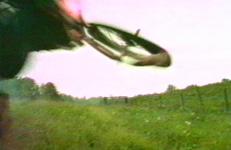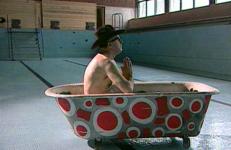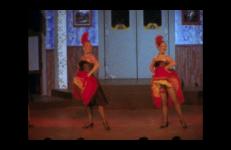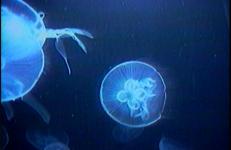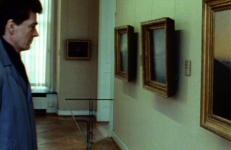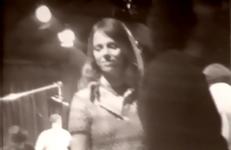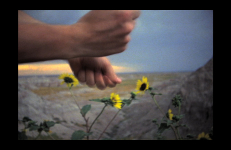Juxtaposing the text of Off Limits, a film made in 1987 about Saigon circa 1968, with the soundtrack and image of the last five minutes of Easy Rider, made in 1968, Tajiri parallel edits these representations to play with the evocation and emptiness of the image. Tajiri blacks out the screen image of Easy Rider while the words of a Vietnamese assassin crawl up the screen, building a structure of selective memory. Tajiri’s Off Limits points to the similarities and contradictions between 1960s hippie iconography and memories of the Vietnam War.
History
In okay bye-bye, so named for what Cambodian children shouted to the U.S. ambassador in 1975 as he took the last helicopter out of Phnom Phenh in advance of the Khmer Rouge, Rebecca Baron explores the relationship of history to memory.
1968 was the opening of the Summer Olympics in Mexico City, ten days after the massacre of students and civilians by military and police on October 2 in the "Plaza de las Tres Culturas, Tlatelolco."
On the Flies of the Market Place deals with the idea of the European space, divided and sacrificed. In a visually surreal world of facts and emotions—using documents from books and magazines—the video suggests a re-reading of the European space, i.e. Eastern and Western Europe. Referencing history, philosophy (Kant), and art, the video elaborates on the idea of Eastern Europe as the indivisible residua of all European atrocities. Eastern Europe is a piece of shit and the bloody symptom of the political, cultural, and epistemological failures of the 20th century.
On the Flies of the Market Place deals with the idea of the European space, divided and sacrificed. In a visually surreal world of facts and emotions—using documents from books and magazines—the video suggests a re-reading of the European space, i.e. Eastern and Western Europe. Referencing history, philosophy (Kant), and art, the video elaborates on the idea of Eastern Europe as the indivisible residua of all European atrocities. Eastern Europe is a piece of shit and the bloody symptom of the political, cultural, and epistemological failures of the 20th century.
On the Way to the Moon, We Discovered the Earth is a short film that remixes archival material from a prominent mainstream newspaper printed during the New York City Blackout in July 1977. The 1977 New York City Blackout is cited as the official birth of hip-hop, wherein looters took equipment that allowed them to formalize and professionalize hip-hop. Titled after a quote by an astronomer looking back at the Earth during the Apollo space mission, this kaleidoscopic film hints at a cultural moment of rupture and reinvention that transcends resilience.
The urge to relieve a winter valley of permanent shadow and find fortune in alluvial gravel are part of a long history of desire and extraction in the far Canadian north. Cancan dancers, curlers, ore smelters, former city officials and a curious cliff-side mirrored disc congregate to form a town portrait. Shot on location in Dawson City, Yukon Territory.
Over The Horizon is a moving image installation that takes its name from the failed radar system developed on Orford Ness in Suffolk during the Cold War. The building that housed it and its aerial field are now used to broadcast the BBC World Service to Europe. Over The Horizon revisits the site where my earlier film Cobra Mist was made and explores through photography and sound the memory of a place, the remnants of history and evidence of stories true or rumoured.
The four‐part cycle Parallel deals with the image genre of computer animation. The series focuses on the construction, visual landscape and inherent rules of computer-animated worlds.
“Computer animations are currently becoming a general model, surpassing film. In films, there is the wind that blows and the wind that is produced by a wind machine. Computer images do not have two kinds of wind.”
-- Harun Farocki
The four‐part cycle Parallel deals with the image genre of computer animation. The series focuses on the construction, visual landscape and inherent rules of computer-animated worlds.
"Computer animations are currently becoming a general model, surpassing film. In films, there is the wind that blows and the wind that is produced by a wind machine. Computer images do not have two kinds of wind."
— Harun Farocki
The four‐part cycle Parallel deals with the image genre of computer animation. The series focuses on the construction, visual landscape and inherent rules of computer-animated worlds.
"Computer animations are currently becoming a general model, surpassing film. In films, there is the wind that blows and the wind that is produced by a wind machine. Computer images do not have two kinds of wind."
—Harun Farocki
Partially Buried explores a web of genealogical traces. In this work the artist probes the notion of sites of memory as well as site-specific work by focusing on the location of Kent, Ohio. Partially Buried references the year 1970 during which the artist Robert Smithson produced his site-specific work, Partially Buried Woodshed at Kent State University. By chance the mother of the child in the video was present also in Kent State in May of that year, studying experimental music. In May of 1970, four students were shot while attending a rally protesting the U.S.
A meditation on the elusiveness of Jewish history set against the backdrop of contemporary Poland.
Peggy and Fred meet up with Peter the Penguin, to once again make their way through the fragmentary remains of 20th Century American culture. They fashion a tumultuous, arbitrary world that teeters dangerously on the edge of nonsense and oblivion. The makings are familiar: technologies, accoutrements, and stories of our culture, leveled against an endless and disorderly horizon.
People enjoy my company connects the privatisation of telecommunications with techno-optimism, euphoria and online communication in the lead-up to the millennium.
The film explores the privatisation of the Irish state-owned telecommunications company Telecom Éireann from the viewpoint of shareholders communicating on early online forums. The event is contextualised within ideologies of technological emancipation in the pre-millennium period.
"Persistence was shot in 1991-92 in Berlin, and edited with films by U.S. Signal Corps cameramen in 1945-46, obtained from Department of Defense archives. Interspersed through these materials are filmic quotations from Rossellini's Germany Year Zero (1946). A meditation on the time just after a great historical event, about what is common to moments such as these—the continuous and discontinuous threads of history—and our attachment to cinematic modes of observation that, by necessity, shape our view of events.
“Video is a fugitive medium,” said Getty Research Institute’s Glenn R. Phillips, and he should know. As curator for California Video, a 2008 at the Getty Museum, he enjoyed the luxury of a massive archive produced during the 1960s, 70s and 80s. Most of the tapes, recorded in obsolete formats, were crusted with oxidation, making the work unwatchable and threatening to ruin any deck that would play them. Jonathan Furmanski, an Assistant Conservator at the Institute, describes one particularly unruly video installation, Philo T.
The latest in Muntadas and Reese's series documenting the selling of the American presidency features political ads from the 1950s to ads from the 2012 campaigns, and highlights the development of the political strategy and marketing techniques of the TV campaign process.
The latest in Muntadas and Reese's series documenting the selling of the American presidency features political ads from the 1950s to ads from the 2012 campaigns, and highlights the development of the political strategy and marketing techniques of the TV campaign process.
A flowing river, an injured arm, a dance floor, and a woman washing clothes in the bay—what carries the dust is the wind.
Screenplay | Chi Jang Yin and Elizabeth Feiertag
Produced, director, edited, video effects, main cast | CHI JANG YIN
Cinematographer | Ross Heran
Sound editor and mixer | Lou Mallozzi
This tape, shot in April 1971, documents the making of a WNET/13 TV show about video collectives and how they use the new video technology.
I reconcile the violent act. Project Gasbuggy pertains to the site where the first of three nuclear bombs were dropped a mile into the earth as part of a government collaboration with natural gas companies to see if nuclear energy could be used to free up natural gas in the earth. As a result of the radiation from each explosion, the land was labeled a dead zone where no harvesting or development of any kind is allowed.
Putting the Balls Away is a reenactment of the historic September 21, 1973, tennis match between Billie Jean King and Bobby Riggs, created for broadcast on the 35th anniversary of the original event. The Battle of the Sexes was the most-watched live sporting event at that time, and pitted chauvinist against feminist, when women tennis players demanded equal pay to that of their male counterparts. Both players are performed by Mateik, whose work wages strategic operations to overthrow institutions of compulsory gender. After each game the competitors "switch sides".
Taking its name from the Jim Crow-era of black criminals staring at white women, this hand-processed, optically-printed amalgam reframes desire by way of everything from D.W. Griffith to Foxy Brown and Angela Davis: 'Your lover belongs to this band of murderous outlaws.'
–– Cinematexas International Short Film Festival
This version of the film is a 2K restoration made by the Academy Film Archive in 2022.
Sixty-five years after the Allied invasion of Southern France, the director's mother, Cecily Barker Finley, tries to recall her involvement as a social worker aboard a WWII Red Cross ship. These memories are recorded in letters and phone calls with her daughter who is living on the coast of France where the invasion occurred. After her mother dies, she discovers a trunk, unopened since the 1940’s in the family garage that is filled with her mother's Red Cross memorabilia. By carefully documenting the trunk's contents, missing pieces of the invasion story begin to come into focus.




